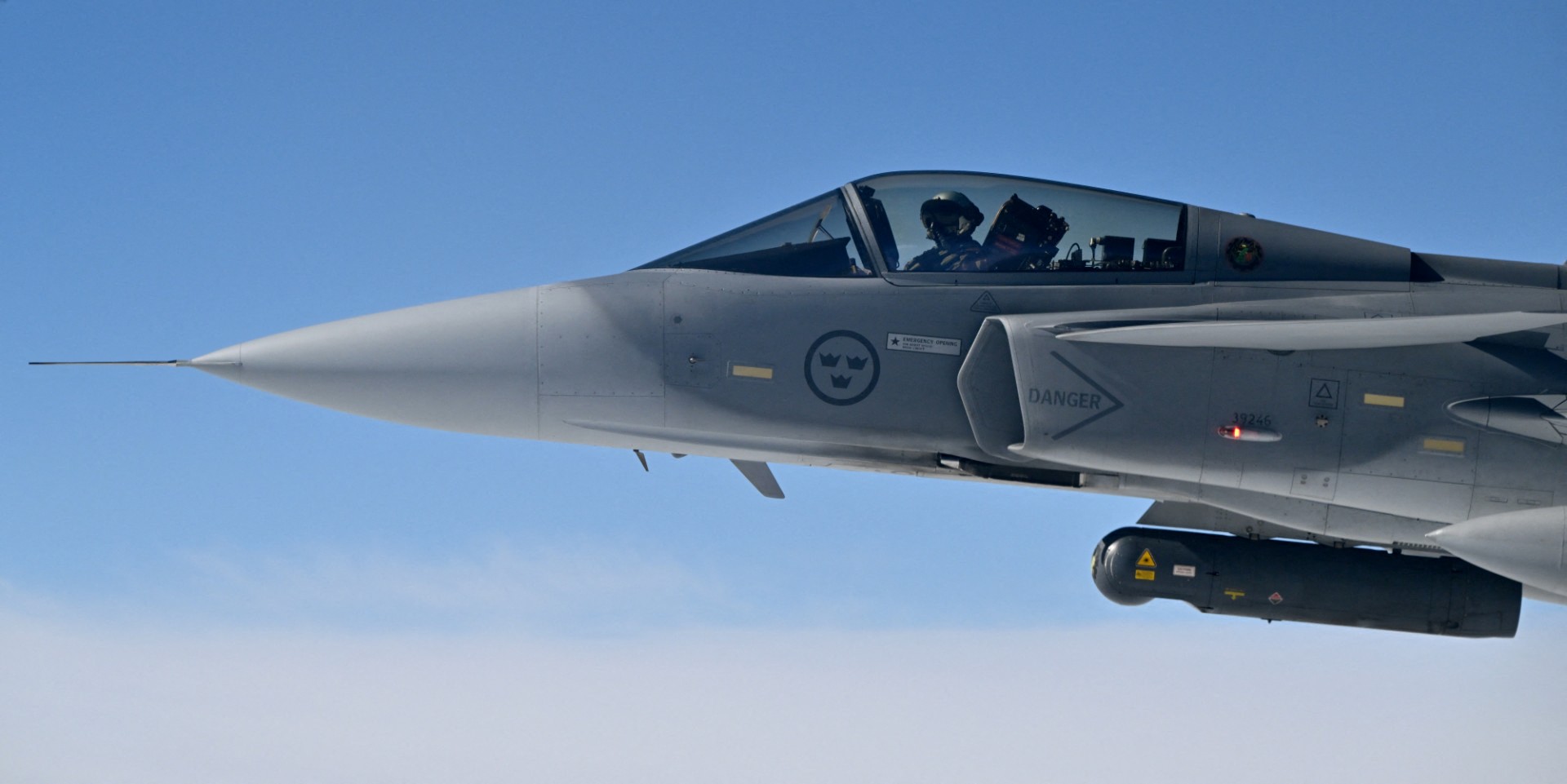“Clear Edge” Over Sukhoi Fighters! Why Gripen-E Jets For Ukraine Could Give ‘Cold Sweat’ To Russian Military

After a decade-long dry spell, it is raining orders for Saab Gripen-E multi-role fighter jets.
After Sweden, Thailand, and Colombia, war-torn Ukraine has now taken the first step toward procuring these cutting-edge fighter jets. If all goes according to plan, Kyiv could become the biggest operator of the Gripen-E aircraft.
On October 22, the Swedish Prime Minister Ulf Kristersson and Ukrainian President Volodymyr Zelenskyy signed a letter of intent (LOI), with the aim of “deepening air force cooperation,” including the export of about 150 Saab Gripen-E fighter jets.
The Swedish Prime Minister said that a major export deal covering “likely between 100 and 150 fighter jets” is at the heart of this LoI, which was signed after Zelenskyy was given a hands-on demonstration of the aircraft at Saab’s facility in Linköping.
“Sweden supports the development of Ukraine’s future air force,” the Swedish government said in an official statement following the signing. “This new Swedish–Ukrainian cooperation will include exchange of experience and knowledge on air combat and defense and on the use of advanced capabilities in this area, for example, fighter aircraft.”
Notably, the development comes a little over a month after Swedish Defense Minister Pål Jonson said the country could eventually sell the Gripen E/F to Ukraine. However, Jonson added a caveat that the sale would only take place after the end of the grinding war.
“We have a dialogue also with Ukraine, and since they certainly expressed an interest in the Gripen system … predominantly Gripen Echo, the new version that Sweden, Brazil are operating as well,” then a future sale is a possibility, Jonson said at the time. “That case … would be more of a long-term endeavor or building a common air force capability as well,” in the same way other buyers have benefited from acquiring the Saab aircraft.
Although the Swedish Prime Minister did not specifically lay down such a condition, he said it will take about 3 years for the newly built Gripen E to reach Ukraine.

Zelenskyy, on the other hand, said he would like to see Gripen arrive in the country starting in 2026 to address the Air Force’s pressing requirements.
“We fully realize it’s a long road ahead of us, but from today, we are committed to exploring all the possibilities in providing Ukraine with a large number of Gripen fighters in the future,” Kristersson said, indicating that the talks are in a very nascent stage.
The Swedish government stated that it would leverage Ukraine’s “unique experience of air combat and defense” to develop systems such as the Gripen further. Sweden aims to learn from Ukraine’s wartime experience to refine Gripen capabilities.
Interestingly, the LoI was signed right after the Swedish Air Force received the first of its 60 Gripen-E.
The LoI marks a tectonic shift in Sweden’s policy, especially after the country rejected all Ukrainian requests for Gripen jets over the last three years. Despite securing the F-16 and the Mirage 2000-5, the Ukrainian administration has been unable to secure the Gripen despite intense lobbying.
In 2023, Sweden indicated it was evaluating a limited transfer of its older Gripen jets to Ukraine. It also offered the Ukrainian pilots an opportunity to receive training on the aircraft.
However, it did an about-face in 2024, saying that it could provide Gripens after the “F-16 program is completed.” The proposal was subsequently shelved after NATO allies cautioned that integrating two different Western-origin fighters simultaneously could put pressure on logistics and training.
After the LoI was signed, several experts suggested that Sweden might finally approve the transfer of the older Gripen C/D that Ukraine has been seeking. However, the Swedish government refrained from publicly addressing that possibility.
EurAsian Times understands that this is merely a showcase of intent to purchase the aircraft and does not guarantee if & when the deal will be finalized.
The sale of over 100-150 Gripen-E jets would revive the aircraft’s fortune in a big way, especially since these cutting-edge fighters have lost to the French Rafale and US F-35 Lightning II in fighter jet contracts across Europe and beyond.
It was only last year that Thailand announced the acquisition of the Gripen-E, ten years after the fighter jet was sold to Brazil. This was followed by Colombia announcing in April 2025 that it was poised to acquire the Swedish jet.
Meanwhile, Canada is also exploring the purchase of the Gripen E as it reconsiders the F-35 amid tensions with the US.
Gripen-E To Fight Russia?
Saab describes the Gripen-E as “designed to defeat any adversary. Designed for forward-thinking air forces, Gripen E incorporates cutting-edge technologies and the latest systems, sensors, weapons, and pods to ensure combat advantage and deliver air superiority in highly contested environments. Silent networking and total sensor fusion across a tactical air unit to blind and confuse the enemy. One aircraft is active, the others go passive.”
The E-Series represents a continuation of the lineage that began with the original Gripen-A single-seat and Gripen-B two-seat variants. Although the single-seat E-model’s outward design is largely similar to its predecessors, it offers several notable improvements.
Saab promises that the Gripen-E redefines the rules of the game by providing the first missile-launch opportunity and the first kill. Saab claims its design represents a breakthrough, allowing it to swiftly integrate new hardware and update software applications to adapt to evolving mission requirements.

The Gripen E is equipped with the AESA (Active Electronically Scanned Array) radar, advanced infrared search and track (IRST) systems, and cutting-edge electronic warfare (EW) capabilities. These allow it to detect, track, and engage multiple targets at long ranges, even in contested environments.
The Gripen E can seamlessly switch between air-to-air, air-to-ground, and reconnaissance missions. It supports a wide range of NATO-compatible weapons, including AMRAAM, Meteor missiles, and precision-guided munitions like JDAMs, enabling Ukraine to conduct strikes against Russian ground targets, defend airspace, and gather intelligence.
The Gripen was specifically designed with a threat from Russia in mind. This aircraft can take off and land quickly, allowing it to operate from taxiways, small public airports, and motorways. This allows them to undertake scattered operations.
Moreover, it can be maintained and rearmed by small crews (as few as six personnel) in under 20 minutes, reducing reliance on large, vulnerable support infrastructure.
In fact, the aircraft does not need to be at specified maintenance facilities, as designated mobile maintenance crews use military vehicles and vans to deliver fuel, ammo, and other components to the aircraft’s location.
SAAB claims that refueling and rearming, including reloading the cannon and adding air-to-air missiles, can be completed in less than 10 minutes by a single technician and five conscript mechanics.
Thus, it is ideal for Ukraine, which is regularly bombarded by Russian drones and missiles.
The Gripen E’s single-engine design and modular systems reduce maintenance costs and downtime. Moreover, it is designed for seamless integration with NATO systems, enabling Ukraine to conduct coordinated operations with allied forces.
The Gripen E can carry Ukraine’s existing Western-supplied munitions and future systems, reducing the need for new weapon stockpiles beyond what it already has.
The Gripen E’s advanced Electronic Warfare (EW) suite and low radar cross-section make it effective against Russia’s S-400 and S-300 air defense systems, which have posed challenges to Ukraine’s current MiG-29s and Su-27s.
Experts like Justin Bronk from the Royal United Services Institute earlier highlighted the Gripen’s suitability for Ukraine’s need to operate from dispersed locations, such as highways, to evade Russian strikes.
Acquiring 100-150 Gripen Es would allow Ukraine to replace its aging Soviet-era fleet, align its air force with NATO standards, and ensure long-term security against regional threats.
Put succinctly, the Gripen E would transform Ukraine’s air force by providing a versatile, cost-effective, and NATO-compatible platform tailored to the demands of modern warfare.
Its ability to operate from austere environments, counter Russian defenses, and integrate with allied systems makes it an ideal fit for Ukraine’s current and future needs.
Earlier, IAF veteran Vijainder K Thakur commented that Gripens would be very effective against Russian Su-35s and Su-30s. “Situational awareness, initial positioning, tactics & weapon system capabilities decide the outcome of air combat. Gripens operating under AWACS cover will have better situational awareness and enjoy an edge over Sukhois.”
- Questions and Answers
- Opinion
- Motivational and Inspiring Story
- Technology
- Live and Let live
- Focus
- Geopolitics
- Military-Arms/Equipment
- Segurança
- Economy
- Beasts of Nations
- Machine Tools-The “Mother Industry”
- Art
- Causes
- Crafts
- Dance
- Drinks
- Film/Movie
- Fitness
- Food
- Jogos
- Gardening
- Health
- Início
- Literature
- Music
- Networking
- Outro
- Party
- Religion
- Shopping
- Sports
- Theater
- Health and Wellness
- News
- Culture

